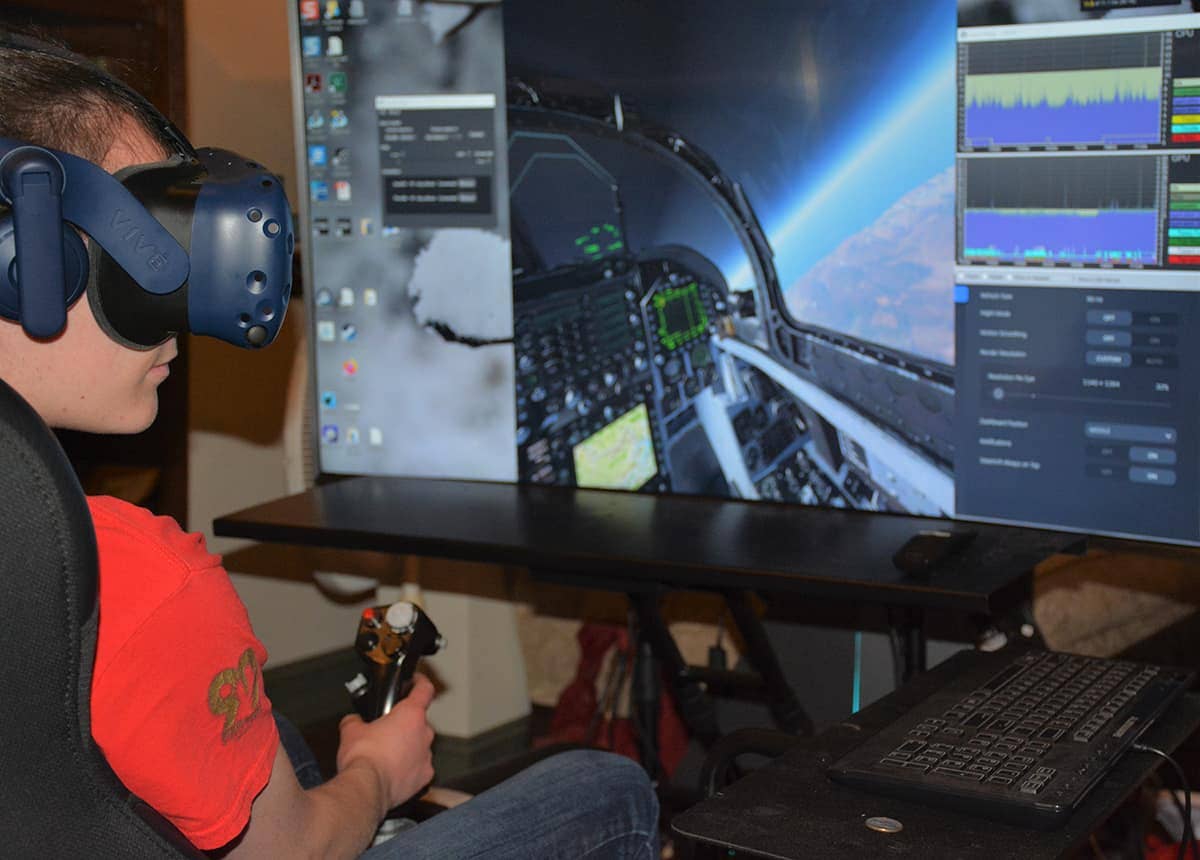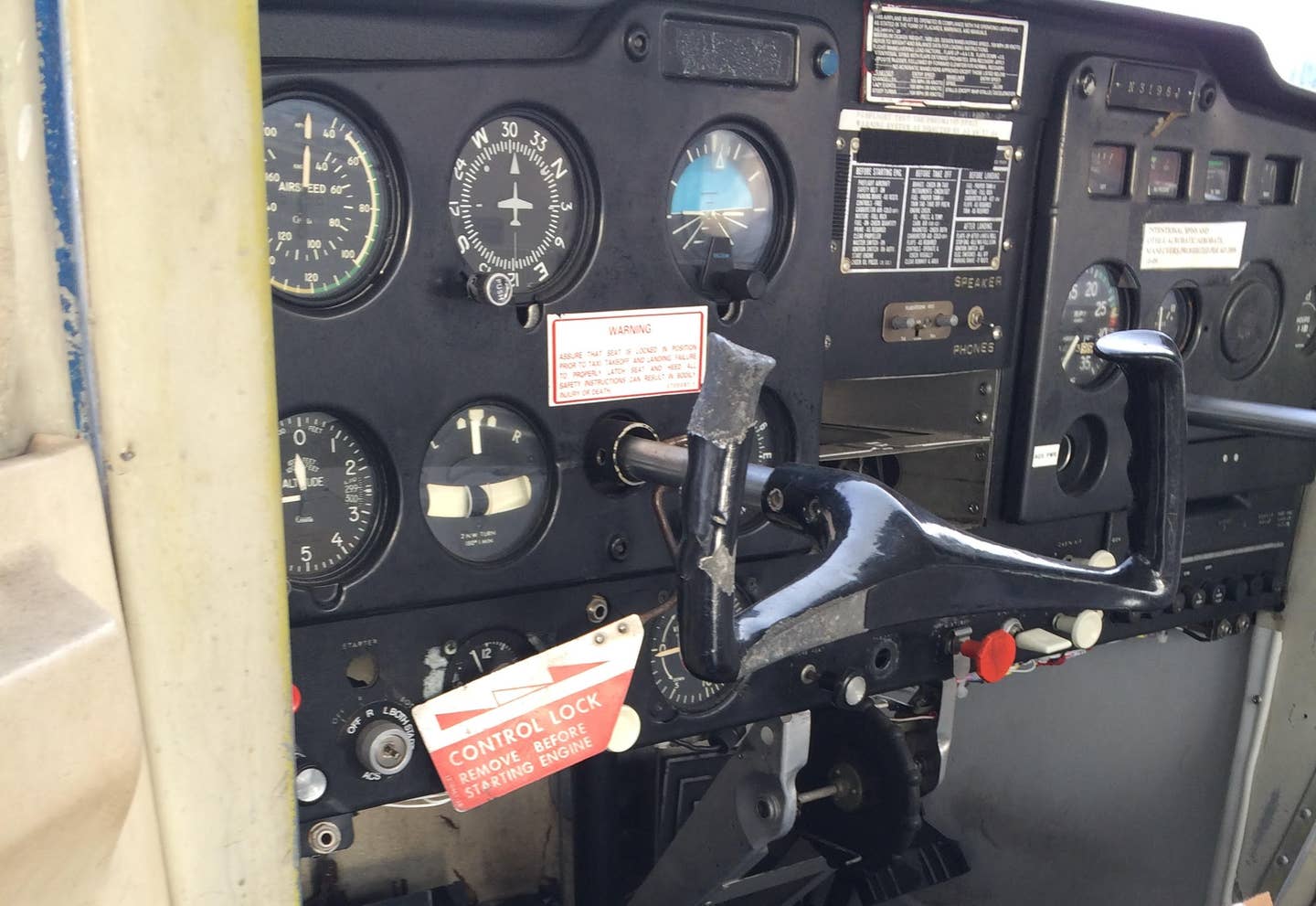Virtual Reality’s Impact on Flight Training Continues to Grow
KLM Airlines and Embry-Riddle Aeronautical University are two entities using this new technology.

Jayla Thirtyacre, a senior in the Prescott Campus Cyber Intelligence and Security program, with math and computer science minors, tests the controls in Embry-Riddle’s virtual reality flight simulator. [Photo: David Thirtyacre/Embry-Riddle Aeronautical University]
VR is here to stay.
In December, I offered a window into how virtual reality was being implemented in flight training and suggested it could be an essential tool in lowering training costs for the next generation of pilots. I couldn't anticipate the overwhelming interest that I'd receive from readers eager to learn more. It has only expanded my perspective on how critical this technology will be in training moving forward. Since then, two things have caught my attention that merit an update. In February, Chris Koomen, a virtual reality engineer and specialist at Air France–KLM Airlines Group, posted this viral walkaround video that his department produced. A pilot in training would be able to use the Oculus Quest 2 for business headset goggles and module for initial training on the 787.
How KLM Airlines Uses VR Training for Pilots
I reached out to Chris to understand how VR is being used at an airline level to train pilots. Koomen says he began working with virtual reality many years ago, and his effort caught the attention of his company, who asked him to help implement it for their training departments once they saw the potential. Presently, he creates 360-degree videos and photos, like the one he posts, and manages all the devices there.
In the video, he said he was actually in an office wearing the VR headset with the pre-defined proprietary content built-in for the pilots to use. Pilots can take the headset home to practice on their own, or to complete flight-deck familiarization or walkarounds—a much more efficient process.
How much more efficient?
"For the Embraer flight deck training—normally they did a startup procedure in the cockpit for the first time within one hour or so," Koomen said. "Now, they do it in 15 minutes because they already know the distances, how to start it up, and all those procedures are practiced in the headset."
He said the airline has built a variety of scenarios and environments that the pilots can also access via the internet, such as 360-degree videos of a crew completing a landing, which allows the viewer to be fully immersed.
"We also sell it to schools. When the school is training, they train a cabin fire, for example, with multiple pools, fire safety tagging, and a jet bridge training to connect the bridge to the aircraft," Koomen said. "We have a pushback simulator where you can simulate a pushback on a simple airport and smaller things like evacuations and door training." It seems the possibilities are endless. Eventually, Koomen mentions, there could be a more significant use case for aviation mechanics.
Some of the training—especially for pilots in recurrent training—is supplemented with modules on iPads, which also allow them to complete walkarounds or emergencies. Koomen suggests this could be more convenient for pilots who won't need to travel anymore or go to the aircraft, which offers measurable steps towards sustainability.
How About Crew Training?
For the most part, aviation is a crewed profession, so I wondered how this would translate if pilots trained independently? He said the airline had already built some multiplayer scenarios that allow two pilots and an instructor to work together—such as a cabin fire.
"You've got two headsets, two trainees, and one instructor. The instructor starts the fire wherever and whenever he wants, and the trainees need to act on it." But does the crew work well together? Koomen said while some are getting used to the new environment, trainees have adjusted.
"The moment you set things on fire, they see smoke filling the aircraft, the passengers coughing, and they hear the instructor—their adrenaline starts to climb. You'll see them take action to activate their skills, talking with each other and working with each other to extinguish the fire before it's too late."
Regulations and Challenges
So, this begs the question—how is this regulated? Koomen explained that the Dutch government allows the tool for in-house training. When the program was announced, the company said the VR courses complement KLM’s existing training program and that it was trying to obtain EASA certification for the course, which would eventually replace some of the standard training components, such as classroom instruction, the cockpit poster, and textbooks.
So, aside from being a familiarization tool, it is a part of training, though pilots who aren't comfortable with the setup yet can opt out.
"Trainees can use it, but they don't have to because there are also people who get lost using it."
Still, nausea seems to be one of the easier challenges to manage. Managing the device's dataset and security presents a more pertinent problem because many commercial headsets are industry-agnostic and are built for the broadest use cases. This creates other unwanted scenarios around data management and headset security that these new departments will have to anticipate.
On the other hand, as this new field develops, these challenges are also opportunities for people who want to get involved in the training industry, but not like before. Koomen said one of the biggest challenges to the technology maturing would be graphic design, or better, gaming development. Training the next generation on these technologies will then be necessary. He said that this is why there are now a handful of public schools in Holland that introduce students to the airline environment.
Embry-Riddle Successes
The other thing that caught my attention is the progress on this side of the pond. Around the same time, Embry-Riddle Aeronautical University provided an update on its PILOT program. PILOT stands for Pre-flight Immersion Laboratory for Operations Training. The university created it to increase the student training capacity of the Daytona Beach Flight Training Department by increasing the efficiency of private pilot training.
The goals are to increase student throughput, improve student aircraft preparation, decrease overall training time, and decrease private pilot training costs. A semester after implementing VR technology, the university said a "group of 58 flight students at Embry-Riddle Aeronautical University reduced the time it took them to complete a first solo flight by more than 30 percent."
VR Can Help You Work the Radios Better
Another program feature is a virtual air traffic control lab with multiple elements that expose students to aviation English at a more manageable pace with a guiding virtual instructor and allows them to practice on their own later.
"In the final stage of radio training, students enter a VR flight to test their skills in Simulated Environment for Realistic ATC (SERA) training technology developed by a company called Advanced Simulation Technology inc. (ASTi). As they speak with ATC, the SERA system uses artificial intelligence software to react to what the student pilot is saying as their flight progresses, correcting them when they make mistakes," the university said.
At the time, Ken Byrnes, chair of the Flight Department at Embry-Riddle's Daytona Beach, Florida, campus, shared that "students who go through our new training program are better prepared when they step into an airplane. They also have lower anxiety and greater confidence due to their experience and understanding of what to expect in the aircraft."
When Byrnes presented an update at the Air Charter Safety Symposium in April, he shared in a presentation for the university that early completions have averaged 18 percent below the 2020-21 median cost to complete the private pilot course. Moreover, students seemed better prepared, less anxious, and demonstrated a higher mastery of the radio.
As the industry grapples with an actual pilot shortage, here is one tool that—even though it will require some adjustments to the way we do things—could materially make flying more accessible for would-be pilots. At the professional level, this could reduce the strain on training departments already at capacity and lower training costs.

Subscribe to Our Newsletter
Get the latest FLYING stories delivered directly to your inbox






